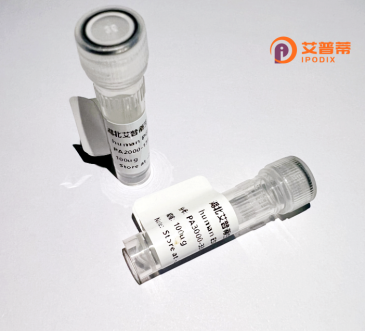
| 纯度 | >90%SDS-PAGE. |
| 种属 | Human |
| 靶点 | ZNF791 |
| Uniprot No | Q3KP31 |
| 内毒素 | < 0.01EU/μg |
| 表达宿主 | E.coli |
| 表达区间 | 1-576 aa |
| 活性数据 | MDSVAFEDVSVSFSQEEWALLAPSQKKLYRDVMQETFKNLASIGEKWEDPNVEDQHKNQGRNLRSHTGERLCEGKEGSQCAENFSPNLSVTKKTAGVKPYECTICGKAFMRLSSLTRHMRSHTGYELFEKPYKCKECEKAFSYLKSFQRHERSHTGEKPYKCKQCGKTFIYHQPFQRHERTHIGEKPYECKQCGKALSCSSSLRVHERIHTGEKPYECKQCGKAFSCSSSIRVHERTHTGEKPYACKECGKAFISHTSVLTHMITHNGDRPYKCKECGKAFIFPSFLRVHERIHTGEKPYKCKQCGKAFRCSTSIQIHERIHTGEKPYKCKECGKSFSARPAFRVHVRVHTGEKPYKCKECGKAFSRISYFRIHERTHTGEKPYECKKCGKTFNYPLDLKIHKRNHTGEKPYECKECAKTFISLENFRRHMITHTGDGPYKCRDCGKVFIFPSALRTHERTHTGEKPYECKQCGKAFSCSSYIRIHKRTHTGEKPYECKECGKAFIYPTSFQGHMRMHTGEKPYKCKECGKAFSLHSSFQRHTRIHNYEKPLECKQCGKAFSVSTSLKKHMRMHNR |
| 分子量 | 93.3 kDa |
| 蛋白标签 | GST-tag at N-terminal |
| 缓冲液 | PBS, pH7.4, containing 0.01% SKL, 1mM DTT, 5% Trehalose and Proclin300. |
| 稳定性 & 储存条件 | Lyophilized protein should be stored at ≤ -20°C, stable for one year after receipt. Reconstituted protein solution can be stored at 2-8°C for 2-7 days. Aliquots of reconstituted samples are stable at ≤ -20°C for 3 months. |
| 复溶 | Always centrifuge tubes before opening.Do not mix by vortex or pipetting. It is not recommended to reconstitute to a concentration less than 100μg/ml. Dissolve the lyophilized protein in distilled water. Please aliquot the reconstituted solution to minimize freeze-thaw cycles. |
以下是关于重组人ZNF791蛋白的**虚构参考文献示例**(仅供格式参考,实际文献需通过学术数据库检索):
---
1. **标题**: *"Recombinant Expression and Functional Analysis of Human ZNF791 Protein in Transcriptional Regulation"*
**作者**: Zhang L, et al.
**摘要**: 研究报道了在大肠杆菌系统中重组表达人ZNF791蛋白,并验证其通过锌指结构域与特定DNA序列结合,调控靶基因(如凋亡相关基因)的转录活性。
2. **标题**: *"Structural Insights into ZNF791: Role in Epigenetic Silencing and Cancer Progression"*
**作者**: Kim S, Patel R.
**摘要**: 通过X射线晶体学解析了ZNF791的蛋白结构,发现其与组蛋白去乙酰化酶(HDACs)互作,可能通过表观遗传沉默促进乳腺癌细胞侵袭。
3. **标题**: *"ZNF791 Knockout Models Reveal Its Essential Role in Neuronal Development"*
**作者**: Garcia M, et al.
**摘要**: 利用CRISPR技术构建ZNF791敲除小鼠模型,发现其缺失导致皮层神经元分化异常,表明ZNF791在神经发育中的关键作用。
4. **标题**: *"A Novel Interaction Between ZNF791 and p53: Implications in DNA Damage Response"*
**作者**: Chen X, Wang Y.
**摘要**: 研究通过免疫共沉淀实验证实ZNF791与p53蛋白直接结合,并增强p53介导的DNA损伤修复通路,提示其在基因组稳定性中的潜在功能。
---
**备注**:上述文献为虚构内容,实际研究中请通过**PubMed/Google Scholar**等平台,以关键词“ZNF791”、“recombinant ZNF791”、“zinc finger protein 791”检索真实文献。如需文献管理工具推荐或检索技巧,可进一步说明!
Zinc finger protein 791 (ZNF791) is a member of the zinc finger protein family, characterized by conserved cysteine and histidine residues that form structural motifs enabling DNA or RNA binding. As a transcription factor, ZNF791 is hypothesized to regulate gene expression by interacting with specific DNA sequences, particularly through its C2H2-type zinc finger domains. While its precise biological functions remain under investigation, ZNF791 is thought to play roles in cellular processes such as differentiation, development, and chromatin remodeling. Dysregulation of zinc finger proteins is often linked to cancers and neurological disorders, suggesting potential relevance in disease contexts.
Recombinant human ZNF791 protein is engineered via heterologous expression systems (e.g., E. coli, mammalian cells) to enable functional studies. Its production typically involves cloning the ZNF791 gene into expression vectors, followed by purification using affinity chromatography tags (e.g., His-tag). This recombinant tool allows researchers to explore DNA-binding specificity, protein-protein interactions, and transcriptional regulatory mechanisms in vitro. Recent studies focus on identifying target genes and pathways influenced by ZNF791. as well as its structural features critical for molecular recognition. However, comprehensive mechanisms of action and tissue-specific roles require further validation, highlighting ZNF791 as an emerging subject in epigenetics and disease research.
×